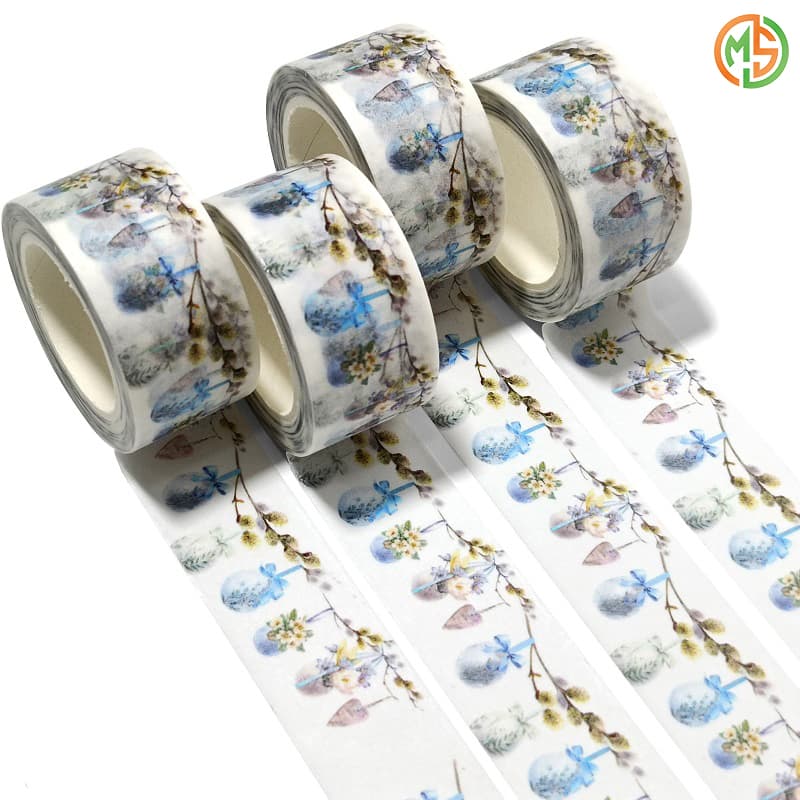As environmental consciousness increasingly permeates all aspects of daily life, practical and eco-friendly products are becoming mainstream. In recent years, washi tape, originating from Japan, has gained rapid popularity in various fields such as packaging, crafts, and office supplies due to its natural and environmentally friendly properties. It has emerged as a "green alternative" to traditional plastic tape, injecting new vitality into the reduction of plastic pollution and the promotion of a sustainable lifestyle.
The environmental advantages of Vintage washi tape primarily stem from its natural raw material composition. Unlike traditional plastic tapes, which are based on non-biodegradable plastics such as polyethylene and polyvinyl chloride, high-quality washi tape is primarily made from natural plant fibers known as "washi." This base material is typically derived from the inner bark of trees such as paper mulberry, mulberry, and Kansai senna, processed using traditional techniques. This natural base material is not only breathable and highly flexible but, most importantly, biodegradable. In natural environments, discarded washi tape gradually decomposes within a few months to a year, eventually turning into harmless organic matter. This avoids environmental issues such as soil and marine pollution caused by the long-term accumulation of plastic tape. Additionally, the adhesives used in washi tape are mostly made from natural rubber or plant starch, free from harmful chemicals such as formaldehyde and benzene. They also do not emit irritating odors during use, safeguarding human health while minimizing secondary harm to the environment.

In practical applications, the environmental value of Self Adhesive Color washi tape becomes even more evident. In the packaging sector, the rapid growth of the e-commerce industry has intensified the problem of plastic waste from express packaging. According to relevant data, China's express delivery industry uses over 10 billion meters of plastic tape annually, most of which is difficult to recycle and non-biodegradable, placing immense pressure on the environment. With its strong adhesion and easy-to-tear properties, washi tape has become a key choice for e-commerce companies and offline retailers adopting "green packaging" initiatives. For instance, several fresh produce e-commerce platforms in China recently introduced "plastic-free packaging solutions," replacing traditional plastic tape with washi tape to seal express boxes. Within just six months, this switch reduced plastic usage by approximately 200 tons. Some luxury brands have also incorporated washi tape into their product gift box packaging. Its natural texture aligns with the brands' high-end image while conveying an environmental message, earning widespread consumer approval.
In creative and office contexts, the eco-friendly qualities of washi tape have attracted a large user base. Craft enthusiasts often use washi tape for scrapbooking, gift wrapping, and DIY projects. Its biodegradable nature ensures that "creative waste" does not become an environmental burden. In office settings, washi tape can be used for securing documents and attaching labels. It removes cleanly without leaving adhesive residue on paper surfaces, maintaining document neatness and reducing waste caused by paper becoming unusable due to leftover glue. Notably, some brands have introduced "recyclable washi tape"—after use, consumers can dispose of it in paper recycling systems, where it undergoes the same regeneration process as paper, enabling resource circularity and further enhancing its environmental benefits

In addition to its inherent environmental benefits, the production process of CMYK Printed Festival Washi Tape also adheres to sustainable principles. Compared to the petrochemical-based production process of plastic tape, washi paper manufacturing consumes less energy, and the cultivation of its natural raw materials also contributes to carbon sequestration. A representative from a domestic washi tape producer stated, "We use raw materials certified by sustainable forestry management, achieve a water recycling rate of over 90% during production, and reduce the product's carbon emissions over its lifecycle by 60% compared to traditional plastic tape."
However, the promotion of washi tape still faces challenges. Currently, washi tape is two to three times more expensive than ordinary plastic tape, which deters some cost-sensitive consumers and businesses. Additionally, some low-priced washi tape products often cut corners by using non-natural base materials or hazardous adhesives. These products not only fail to deliver environmental benefits but may also pose risks to the environment. Industry experts suggest that relevant authorities introduce supportive policies to encourage companies to scale up production of eco-friendly washi tape and reduce costs, while strengthening market supervision and standardizing product quality standards. Consumers should also pay attention to product ingredient labels and choose genuinely environmentally friendly products.
With increasing global environmental awareness and the continued implementation of policies such as "plastic restrictions," the market demand for washi tape is growing rapidly. Industry forecasts predict that over the next three to five years, China's eco-friendly washi tape market will grow at an average annual rate of over 25%, becoming a new growth driver in the packaging and cultural innovation sectors. From daily office use to industrial packaging, from handmade crafts to home decor, washi tape is transforming people's perception of adhesive products with its "green, natural, and recyclable" qualities. It is making a seemingly small yet significant contribution to promoting a "plastic-free lifestyle" and building a beautiful China


 Français
Français English
English Français
Français Deutsch
Deutsch Italiano
Italiano Español
Español







 IPv6 RÉSEAU PRIS EN CHARGE
IPv6 RÉSEAU PRIS EN CHARGE
